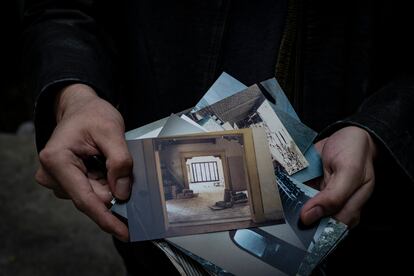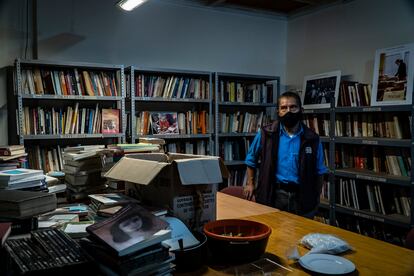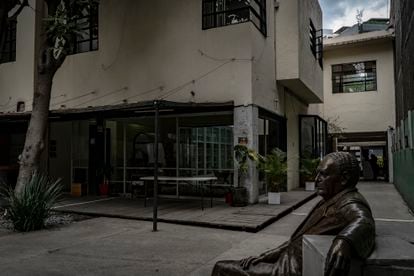Xhevdet Bajraj and Shaomy Medina are separated by everything except the walls that kept them. He torments and woos words, she dances to all the modern music, he sports a mustache and she a pair of braids, they escaped in 1999 and also yesterday, from Kosovo or Honduras, with children in tow and at 15 years old, because of the extermination and the gangs. For both, fear is the same, for both it is exile, and for both, in the end, the same lair. The Casa Refugio Citlaltépetl, located in the Condesa neighborhood, has been a stopover for decades, a shelter for those who start over in Mexico City. Now that the guests have changed and it is no longer occupied by writers from the former nations at war but by two libraries and a multitude of cultural projects, this mansion faces a total lack of public budget to maintain itself.
The house was already there before the others arrived. Built in the 1920s, it had a frieze floor, a filthy roof terrace and large windows overlooking the garden, a slightly twisted staircase. It was designed by the architect Enrique Aragón Echegaray, who also designed the Altar to the Fatherland, in Chapultepec Park, or the monument to Álvaro Obregón, in La Bombilla, south of the city. Starting in 1940, Citlaltépetl 25 was the home of Republicans who fled the Spanish Civil War, they were the first exiles who settled in the house.
The project began in 1998, when the head of the Government of Mexico City, Cuahtémoc Cárdenas, named the capital a city of refuge, with José Saramago and Carlos Fuentes as witnesses. The then Federal District joined a network of 25 cities that enabled spaces to welcome writers in danger, the one in Mexico was the only one outside Europe. The idea of the system came from Salman Rushdie, the Indian writer, exiled in the United Kingdom, persecuted by Islamic fundamentalists after his book the satanic verses. Rushdie founded, to manage the network, the organization International Parliament of Writers, and between all of them they chose the house.

The remodeling was carried out by Felipe Leal, defined by the press at the time as “one of the most complete architects on the Mexican scene (…), author of countless residencies for designers, writers and cultural heroes. Always attentive to the latest trends. Thus Leal appropriated a light patio, transformed garages into offices and adapted three rooms in the building for refugee writers. At the beginning of January 1999, Rushdie himself came as a surprise to visit the house and everyone was there to welcome him: Carlos Monsiváis, Carmen Boullosa, Marta Lamas, Juan Villoro, Álvaro Mutis. “A meeting of friends that until the end will only carry a little cloud: and Carlos Fuentes?”, he wrote Reform in his chronicle of the meeting.
Rushdie seemed pleased: “It is very important that authors are not only judged by their words, but also by their actions: by what they can do to help their colleagues in danger,” said the writer in the backyard of Citlaltépetl while a discreet Scotland Yard diligence kept an eye on the Countess’s surroundings for him. And so the house started to work.
Albanian poet Xhevdet Bajraj arrived in June 1999 with his wife and two children after leaving a shattered Kosovo. They settled in one of the apartments, from where the narrator presented his first bilingual collection of poems, albanian beg. “Here I am born again, it is the first time in 10 years that I am not afraid that they will come to my door to arrest or kill me. Mexico is like a dream: you open the window and the color explodes before your eyes”, he said in an interview after a few months installed.
After him came a dozen other authors, most from Africa and the Middle East. Part of his literary creation was printed in the magazine vanishing line, by the publisher Philippe Ollé-Laprune, who also directed the Casa Refugio Citlaltépetl until 2017 when the association of the International Parliament of Writers was dissolved, the mansion came under the control of the city’s Secretary of Culture and no writer came back refugee.
The last whiskey of the writer Lorna Martínez

When the earth began to shake on September 19, 2017, Lorna Martínez Skossowska was 86 years old. She realized that she could not leave her building, located at 107 Amsterdam Street, so she asked the girl who took care of her daily to serve her a whisky and quickly run down. The writer was buried, but her library sprouted. “When the people trapped by the earthquake were rescued, we began to see some books blooming among the rubble,” explains María Cortina, director of the Citlaltépetl Refuge House. The mansion, which had been adrift for a few months, then became a food storage and rest center for some 70 rescuers who participated in the emergency. Later, it was the den of the neighbors’ books.
“The building that collapsed is about three blocks away, so we formed a book rescue brigade and brought them from there arm in arm,” explains Cortina. It had rained and a building had fallen on them, so a group of young people from the National Autonomous University of Mexico (UNAM) restored them for free. The owners of the works decided to donate practically all of them, so now more than 3,000 volumes are stacked in a dark, still messy room, next to the main house. They are the books of the neighbors — among which was the great-grandson of Leon Trotsky — so they jump from English to Russian and from there to movie scripts, architecture or novels. They have called the space: Biblioteca 19-S, where all the works can be consulted from Monday to Saturday until five in the afternoon.
It shares hours and a patio with its neighbor, the Javier Valdez Library. The journalist, founder of the weekly Riodoce, was assassinated on May 15, 2017 in Culiacán, Sinaloa. One of the great chroniclers of drug violence in Mexico was killed on his knees. After the crime, Griselda Triana, his wife, arrived displaced in Mexico City. She remembers the first months in the capital, where she had practically arrived with nothing on her back, isolated and scared. “I didn’t bring Javier, his ashes, because he never wanted to leave Culiacán, that’s why they killed him, he had the opportunity to leave and he didn’t want to,” he says. The Citlaltépetl Refuge House was his springboard to start leaving the house. The workshops and conferences for journalists that were given in the space were their first safe movements, here were the first subway trips, some of the first walks.

“If there was one thing that worried me, it was the books in Javier’s library. I was worried that they were in an abandoned house where no one lives anymore, that they would get lost, and, above all, that no one else would read them,” he says. So Triana brought by parcel hundreds of books that belonged to the journalist. On the shelves of this bright and spacious room are also all the works he published, his hat and glasses, some used notebooks, a bottle of whisky in the middle, the photograph of his last birthday: 50.
Over time, reporters and publishers donated other books to the library to accompany the Javiers. In total, there are more than 1,500 works. “I want colleagues to know that this is a place where they can come to work, to read, to present their books, this is a space for their colleagues to come and appropriate it, it is a place for them, to rescue Javier’s memory, of course, but open it up to his fellow journalists,” he says.
While Griselda Triana remembers, above the house they sing. Marco Guagnelli, 33, toured the shelters of Mexico City for weeks, crowded by the arrival of migrant caravans, with the aim of finding those who wanted to dance, sing, move, do theater. In total, he has formed a group of 20 Central American migrants, most of them from Haiti, with whom he is preparing a readjustment of The Tempest, by Shakespeare, which will premiere on Saturdays in February at the Alameda Central. Now, three days a week, for four hours, the group occupies the roof of the Casa Refugio.
“Here I feel free,” says Shaomy Medina smiling. He arrived in the capital a little over a month ago, but he left his home in San Pedro Sula four years ago. She made the trip with her mother and her little sister, who also participate in the workshop, fleeing the misery of the hurricanes and, above all, the gangs. Theater evenings have become the best way to deal with stress and bad dreams for this aspiring dancer.
This type of project has become the essence of the house, which provides free spaces for cultural activities related to migration, refuge or freedom of expression. In return, they ask for donations. The organizers of a creative writing workshop gave them ink for the printers, some neighbors, the booksellers. The Shelter House has not had a public budget for three years, beyond the salaries of its workers.
One of its objectives is to obtain a professional scanner with which to start its most ambitious initiative: to digitize a large part of its bibliographic collection so that it can be consulted online. They also dream of opening a home loan that will allow the two rooms to become true libraries. The director, María Cortina, insists on staying: “Our goal is not to stop, that the Citlaltépetl Shelter House project never ends, that it continue to be a refuge for displaced journalists, for migrants, for mothers in search of their children. , let them feel at home here”.

subscribe here to newsletter of EL PAÍS Mexico and receive all the informative keys of the news of this country
elpais.com
Eddie is an Australian news reporter with over 9 years in the industry and has published on Forbes and tech crunch.